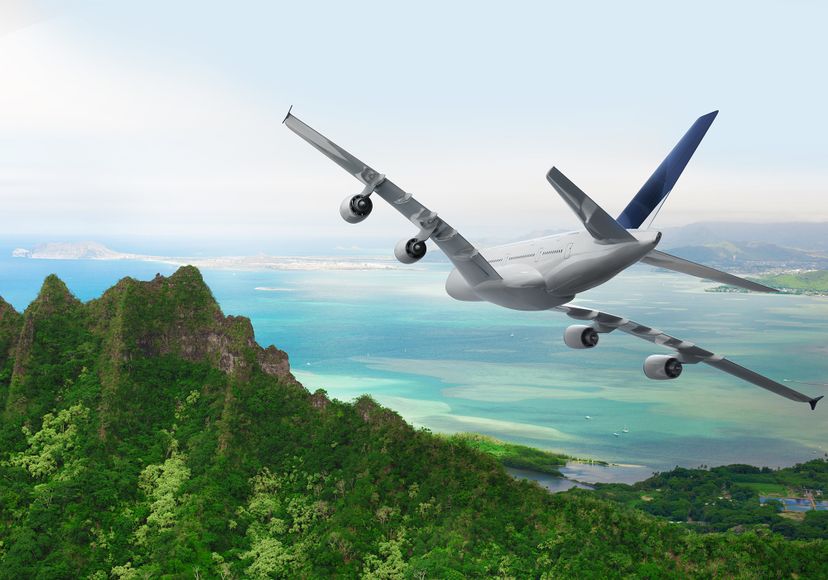
About This Quiz
Long before the Wright brothers guided their fixed-wing aircraft over the North Carolina dunes, daredevils and engineers worked to decode the secrets of sustained heavier-than-air human flight. What do you know about the physics of flight?An airplane flying straight and level at a constant speed has four forces acting on it: lift, drag, weight and thrust. Weight and mass are not the same thing. Mass is a measure of the amount of matter in an object, while weight factors in the downward pull of gravity on an object.
In light aircraft, piston engines drive propellers. Propellers deflect air backward, and this air pushes back, creating thrust. The same principle applies to jet engines, which blast hot, expanding gases to the rear of the plane and, in turn, get pushed back by those same gases.
The forces acting on a plane work in opposing pairs. Weight opposes lift, drag opposes thrust. During steady, level flight, the pilot adjusts the engine power and various control surfaces to keep the opposing forces in balance.
Advertisement
Birds figured it out long before humans: You gotta have wings if you're going to fly. Wings create lift, the upward-acting force that gets your feet off the ground.
Wing sounds so simple, but airfoil soars with sophistication. Technically speaking, an airfoil is the shape of the wing -- a curved surface with a rounded leading edge and a sharp trailing edge.
Daniel Bernoulli and his famous principle get a lot of attention when it comes to lift. A lot of aviation enthusiasts would argue, however, that Bernoulli is only part of the lift story though.
Advertisement
In 2001, David Anderson and Scott Eberhardt published "Understanding Flight" as a practical and intuitive guide to mechanical flight. In the book's opening paragraph, they made a bold statement that many took as heretical: "Forget Bernoulli's theorem."
Move over Bernoulli, Newton wants to fly this plane. According to authors Anderson and Eberhardt, Newton's third law of motion is perfectly capable of explaining how a wing works: Grossly simplified, it says that the wing pushes the air down, so the air pushes the wing up.
When a fast-moving fluid encounters an airfoil, the fluid sticks to the surface and follows the curve. This is known as the Coanda effect, named after Henri Coanda, a Romanian scientist who first described the phenomenon in the 1930s.
Advertisement
On an airfoil, the amount of curvature is determined by the camber line. Airfoils with positive camber -- the upper surface curves more than the lower surface -- generate better lift.
Drag falls into two categories. The first, known as parasitic drag, is related to the friction between the aircraft and the air. The second, known as induced drag, arises as a resistance to lift. Who knew flying could be such a, well, drag?
For an airfoil to work, the leading edge of the wing must be inclined upward. The more it's inclined, the greater the angle of attack. Put another way, the angle of attack is the angle between the chord, or midline, of an airfoil and the direction of the surrounding undisturbed flow of gas or liquid.
Advertisement
The angle of attack is related to the amount of lift. Lift will increase as the angle of attack is increased -- up to a point (called the critical angle of attack). For most aircraft, lift will be maximized if the angle of attack remains below 17 degrees.
While it's true that increasing the angle of attack increases lift, it's also true that you can have too much of a good thing. When the angle of attack becomes too steep, the wing can't generate lift, and the aircraft stalls.
Elevators are hinged flaps located on the tail of the plane. Raising the elevators deflects air downward, which pushes the tail down (and the nose up). Lowering the elevators pushes the tail up (and the nose down).
Advertisement
A roll results in an up and down movement of the wings. Such motion is controlled by two hinged flaps, located on each wing, known as ailerons. When the starboard aileron is raised, it deflects air upward, which produces a downward force on the wing, causing the wing to fall. The opposite occurs when the port aileron is raised.
No, not "yawning" -- that's controlled by something entirely different. Yawing describes an airplane that's turning about its vertical axis. And the aircraft control responsible for that is the rudder. Turn the rudder to starboard, and you'll aim the plane's nose in that direction.
A smooth, graceful turn looks so easy, but it takes a practiced pilot working the rudder and the ailerons simultaneously.
Advertisement
When an aircraft approaches the speed of sound (assuming 660 mph per second at 30,000 feet above sea level), its interaction with the surrounding air changes. That's because the air flowing over the plane is going faster than the plane itself. One of the most important effects is a very large increase in drag, as well as a reduction in lift.
Scientists appreciate convenience as much as anyone else. Because the ratio of aircraft speed to the speed of sound has such important implications for flight, aerodynamicists came up with a convenient way to express the relationship -- the Mach number. Flight that's faster than Mach 1 is classified as supersonic. Flight that's faster than Mach 5 is classified as hypersonic.